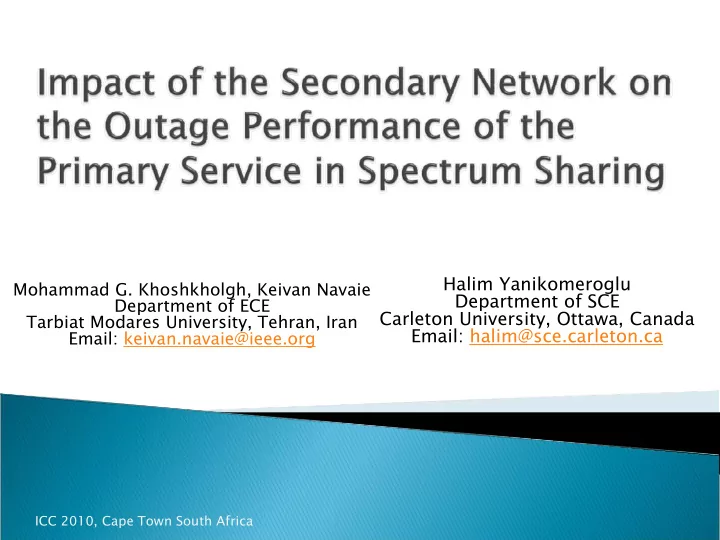

Halim Yanikomeroglu Mohammad G. Khoshkholgh, Keivan Navaie Department of SCE Department of ECE Carleton University, Ottawa, Canada Tarbiat Modares University, Tehran, Iran Email: halim@sce.carleton.ca Email: keivan.navaie@ieee.org ICC 2010, Cape Town South Africa
11/23/2010
11/23/2010
� Existing spectrum policy has full allocation but poor utilization � Spectrum sharing proposed to improve spectral efficiency � Primary service is the licensee � Secondary service utilizes Opportunistic Spectrum Access (OSA) � Secondary service detects and makes use of the spectrum holes/white spaces � Interference threshold is defined as a metric to detect spectrum holes/white spaces 11/23/2010
� To protect the primary service from unacceptable QoS degradation � access to the white spaces subject to no/minimum QoS degradation at the primary receiver � manage the imposed interference at the primary receiver to satisfy the interference threshold � To improve the spectral efficiency � accommodate as much secondary service users as possible � utilize sophisticated power control mechanism � utilize accurate spectrum sensing procedure � . . . 11/23/2010
� To analyze the impacts of To analyze the impacts of the secondary service the secondary service parameters & parameters & the wireless environment on the wireless environment on the the primary service outage probability primary service outage probability ◦ a closed form a closed form is derived is derived for the primary for the primary service outage service outage probability derived based probability derived based on on the the transmit power of transmit power of the the secondary secondary service and miss detection probability of service and miss detection probability of the the spectrum sensing spectrum sensing ◦ the the maximum secondary service transmitter node maximum secondary service transmitter node density is density is obtained for a obtained for a given outage given outage probabili probability ty constrain constraint of t of the the primary service primary service ◦ an upper bound is an upper bound is obtained to obtained to the the achievable capacity achievable capacity of the primary of the primary service service ICC 2010 11/23/2010
Secondary Service Transmitters Primary Service Transmitter Primary Service Secondary Service Receiver Receivers 7
� The secondary service transmitters distributed based on a Homogenous Point ( ) Process λ k s A { } − λ = A Pr k SS in region R e s ! k where A is area of region R. If the spectrum is idle and the spectrum sensing wrongly recognize the spectrum status as busy, a false alarm is occurred. � All secondary service transmitters have ε identical ROC curves, i.e., equal false alarm, , δ and miss detection probability miss detection is occurred in cases where the spectrum is busy and it is mistakenly recognized as idle 11/23/2010
� The channel is available with probability = − 1 p p i b � The set of secondary users which experience miss detection { } % ∏ = ∈∏ = | 1(missdetectionindicator) X D i i λ δ with density p s b � Channel power gain between primary transceiver is exponentially distributed � Channel power gain among secondary transmitters and the primary receiver are independent exponential random variables 11/23/2010
� Received interference at the primary receiver in miss detection experiences = ∑ − α I S X g ϕ , s i sp i ∈∏ i is the secondary service transmission S s power − α is the distance-dependent path-loss X i attenuation is a power law shot noise process I ϕ 11/23/2010
� Obtaining the primary service outage probability surrounding by a secondary network distributed based on Homogenous Point Process � Obtain the maximum number of the secondary transmitters per unit area to satisfy the primary service outage probability constraint ξ � Stochastic Geometry results are utilized for analysis 11/23/2010
� Primary service SINR − α S R g = p p SINR + p W I ϕ � We show that the Primary service outage probability is { } = < γ p Pr P SINR out p th α / 2 ⎛ ⎞ γ ⎛ ⎞ S ( ) α γ − λ 2 ⎜ ⎟ α s th R L R ⎜ ⎟ = − Φ ⎜ μ S ⎟ ⎝ ⎠ th 1 p e ⎜ ⎟ W S ⎝ ⎠ p 11/23/2010
11/23/2010
� We show that the maximum secondary transmitter density for satisfying the primary service outage probability 1 − α ln1 2/ ⎛ ⎞ γ − ξ S λ = ⎜ ⎟ * s th ⎜ ⎟ δ s 2 S R L p ⎝ ⎠ p b 11/23/2010
� The primary service capacity by ignoring the effect of AWGN ( ) 1 = + log 1 C E SINR p p 2 ⎛ ⎞ ( ) S 1 log 1 − α ( ) /2 ≤ + λ Γ α + p 2 ⎜ ⎟ / 2 1 LR 2 ⎝ ⎠ S s 11/23/2010
11/23/2010
� A closed-form expression was derived for the primary service outage probability in Rayleigh fading environment � The maximum secondary service transmitter density was obtained to satisfying the primary service outage constraint � The primary service capacity was analyzed and an upper bound was derived 17
Thanks! Mohammad G. Khoshkholgh, khoshkholgh@modares.ac.ir Keivan Navaie keivan.navaie@ieee.org Halim Yanikomeroglu halim@sce.carleton.ca
Recommend
More recommend